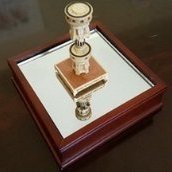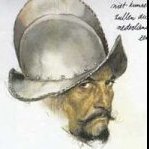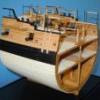MORE HANDBOOKS ARE ON THEIR WAY! We will let you know when they get here.
×
-
Posts
3,867 -
Joined
-
Last visited
Reputation Activity
-
 KeithAug got a reaction from Nirvana in Altair 1931 by KeithAug - FINISHED - Scale 1:32 - schooner
KeithAug got a reaction from Nirvana in Altair 1931 by KeithAug - FINISHED - Scale 1:32 - schooner
Thank you Nils - not quite on the scale of your Kaiser but quite satisfying never the less. Loved your screws - which prompted me to have a go on Altair.
I made a little more progress on the capping rail along the length of the hull. At about .300 inch wide the rail was much too stiff to bend to follow the curvature of the deck edge. I was pretty certain I would be able to bend a rail of half the thickness and so decided to make the width from two planks. I had the option of trying to lay up the rail on top of the plan but decided to form the rail by mounting it directly on the bulwark.
Having cut mahogany strip (.080 x .300 inch) I needed to round the edges. I was considering making a scraper in the form of a "U" and using this on the plank edge to generate the half round...............however i hit upon a simpler solution....................the back of the knife blade.
Mounting the half rail on top of the ribs necessitated drilling and pining the rail to secure it in place while the PVA dried.
I did have slip and a break which required repair.
So far so good!
-
 KeithAug got a reaction from Eddie in Endeavour 1934 by Julie Mo - Amati - Scale 1:35 - America's Cup UK J-Class Challenger
KeithAug got a reaction from Eddie in Endeavour 1934 by Julie Mo - Amati - Scale 1:35 - America's Cup UK J-Class Challenger
Julie - good luck - its always worth trying and sometimes it works better than expected.
-
 KeithAug got a reaction from GuntherMT in Altair 1931 by KeithAug - FINISHED - Scale 1:32 - schooner
KeithAug got a reaction from GuntherMT in Altair 1931 by KeithAug - FINISHED - Scale 1:32 - schooner
Thank you Nils - not quite on the scale of your Kaiser but quite satisfying never the less. Loved your screws - which prompted me to have a go on Altair.
I made a little more progress on the capping rail along the length of the hull. At about .300 inch wide the rail was much too stiff to bend to follow the curvature of the deck edge. I was pretty certain I would be able to bend a rail of half the thickness and so decided to make the width from two planks. I had the option of trying to lay up the rail on top of the plan but decided to form the rail by mounting it directly on the bulwark.
Having cut mahogany strip (.080 x .300 inch) I needed to round the edges. I was considering making a scraper in the form of a "U" and using this on the plank edge to generate the half round...............however i hit upon a simpler solution....................the back of the knife blade.
Mounting the half rail on top of the ribs necessitated drilling and pining the rail to secure it in place while the PVA dried.
I did have slip and a break which required repair.
So far so good!
-
 KeithAug got a reaction from Nirvana in Altair 1931 by KeithAug - FINISHED - Scale 1:32 - schooner
KeithAug got a reaction from Nirvana in Altair 1931 by KeithAug - FINISHED - Scale 1:32 - schooner
Hello Julie
Teakdecking Systems don't offer caulking guns small enough. Gulliver's shipping supplies is the best source. They can be found at Lilliput Lane, Littlehampton.
Hi David - thanks for the comments, i have to make it simple or I make a mess of it.
-
 KeithAug got a reaction from mmdd in Altair 1931 by KeithAug - FINISHED - Scale 1:32 - schooner
KeithAug got a reaction from mmdd in Altair 1931 by KeithAug - FINISHED - Scale 1:32 - schooner
Thank you Nils - not quite on the scale of your Kaiser but quite satisfying never the less. Loved your screws - which prompted me to have a go on Altair.
I made a little more progress on the capping rail along the length of the hull. At about .300 inch wide the rail was much too stiff to bend to follow the curvature of the deck edge. I was pretty certain I would be able to bend a rail of half the thickness and so decided to make the width from two planks. I had the option of trying to lay up the rail on top of the plan but decided to form the rail by mounting it directly on the bulwark.
Having cut mahogany strip (.080 x .300 inch) I needed to round the edges. I was considering making a scraper in the form of a "U" and using this on the plank edge to generate the half round...............however i hit upon a simpler solution....................the back of the knife blade.
Mounting the half rail on top of the ribs necessitated drilling and pining the rail to secure it in place while the PVA dried.
I did have slip and a break which required repair.
So far so good!
-
 KeithAug got a reaction from hexnut in Altair 1931 by KeithAug - FINISHED - Scale 1:32 - schooner
KeithAug got a reaction from hexnut in Altair 1931 by KeithAug - FINISHED - Scale 1:32 - schooner
Thank you Nils - not quite on the scale of your Kaiser but quite satisfying never the less. Loved your screws - which prompted me to have a go on Altair.
I made a little more progress on the capping rail along the length of the hull. At about .300 inch wide the rail was much too stiff to bend to follow the curvature of the deck edge. I was pretty certain I would be able to bend a rail of half the thickness and so decided to make the width from two planks. I had the option of trying to lay up the rail on top of the plan but decided to form the rail by mounting it directly on the bulwark.
Having cut mahogany strip (.080 x .300 inch) I needed to round the edges. I was considering making a scraper in the form of a "U" and using this on the plank edge to generate the half round...............however i hit upon a simpler solution....................the back of the knife blade.
Mounting the half rail on top of the ribs necessitated drilling and pining the rail to secure it in place while the PVA dried.
I did have slip and a break which required repair.
So far so good!
-
 KeithAug reacted to robnbill in Endeavour 1934 by Julie Mo - Amati - Scale 1:35 - America's Cup UK J-Class Challenger
KeithAug reacted to robnbill in Endeavour 1934 by Julie Mo - Amati - Scale 1:35 - America's Cup UK J-Class Challenger
Julie, you might try the technique I use for finding the shape of the plank. I first mark off the hull at the frames the space I need between the planks. So if I have X number of planks at the widest part, then I also need the same number at all the other stations. This only would change if I have drop planks. The rule of thumb is a plank should only narrow to ½ it's width. If it would be smaller than that, there needs to be a drop plank.
Once I know where the lines would be, I use clear scotch tape, the kind that you can write on, and tape it directly on the hull over the area I want to plank. I use a very sharp Xacto blade to trip the top of the tape so it lays tight up against the previous plank. Then I mark the tape everywhere it crosses the marks on the hull.
Remove the tape and stick it to the planking material and use a french curve to create a smooth line between the marks and you have an exact template for the plank. Cut the plank out using the template and bend it according to the hull. Perform a final fitting so it lays smoothly along the previously attached planks and you are good to go.
You could modify this to use on your vertical planking if that is what you decide to do.
-
 KeithAug got a reaction from mtaylor in Endeavour 1934 by Julie Mo - Amati - Scale 1:35 - America's Cup UK J-Class Challenger
KeithAug got a reaction from mtaylor in Endeavour 1934 by Julie Mo - Amati - Scale 1:35 - America's Cup UK J-Class Challenger
Julie - good luck - its always worth trying and sometimes it works better than expected.
-
 KeithAug got a reaction from KORTES in Altair 1931 by KeithAug - FINISHED - Scale 1:32 - schooner
KeithAug got a reaction from KORTES in Altair 1931 by KeithAug - FINISHED - Scale 1:32 - schooner
I so enjoyed the process of wiping on the poly that I had to force myself to stop after 7 coats. I might have to do more later!!!
With the hull sealed I turned it over and started to think about adding the capping rail to the bulwarks. The rail is .080 inch thick and at the stern it varies considerably in width. I started with the stern. I produced a template by pressing a sheet of paper on to the bulwark and then used this to size the 3 planks from which the stern rail would be cut.
I needed to shape the 3 sections as one so I mounted them onto a scrap piece of MDF with double sided tape.This was then sanded using the disc and spindle sanders.
Once sanded the 3 parts were removed from the backing and offered up to bulwark - no further adjustment was necessary but the edges were rounded with sandpaper by hand. The 3 pieces were then glued together before the assembly was glued to the bulwark using PVA.
The stem capping piece will be made in the same way but from 2 pieces.
-
 KeithAug got a reaction from Nirvana in Altair 1931 by KeithAug - FINISHED - Scale 1:32 - schooner
KeithAug got a reaction from Nirvana in Altair 1931 by KeithAug - FINISHED - Scale 1:32 - schooner
I so enjoyed the process of wiping on the poly that I had to force myself to stop after 7 coats. I might have to do more later!!!
With the hull sealed I turned it over and started to think about adding the capping rail to the bulwarks. The rail is .080 inch thick and at the stern it varies considerably in width. I started with the stern. I produced a template by pressing a sheet of paper on to the bulwark and then used this to size the 3 planks from which the stern rail would be cut.
I needed to shape the 3 sections as one so I mounted them onto a scrap piece of MDF with double sided tape.This was then sanded using the disc and spindle sanders.
Once sanded the 3 parts were removed from the backing and offered up to bulwark - no further adjustment was necessary but the edges were rounded with sandpaper by hand. The 3 pieces were then glued together before the assembly was glued to the bulwark using PVA.
The stem capping piece will be made in the same way but from 2 pieces.
-
 KeithAug got a reaction from tasmanian in Altair 1931 by KeithAug - FINISHED - Scale 1:32 - schooner
KeithAug got a reaction from tasmanian in Altair 1931 by KeithAug - FINISHED - Scale 1:32 - schooner
I finished the winch and a couple of minor deck fittings.
The winch base was made from brass sheet and eyelets. The holes were accurately drilled on the mill.
The winch was test assembled before painting.
Then painted with enamel paint - grey undercoat and then gloss black
A couple of other simple items were made on the lathe and mill. The hand-wheel was recovered from a pocket watch - one of a diminishing supply of such items in my odds and ends box.
The winch components were superglued together.
The fore deck components are photographed arranged in their relative positions.
-
 KeithAug got a reaction from KORTES in Altair 1931 by KeithAug - FINISHED - Scale 1:32 - schooner
KeithAug got a reaction from KORTES in Altair 1931 by KeithAug - FINISHED - Scale 1:32 - schooner
Finishing the hull is proving to be quite slow going as the poly is taking ages to dry. I needed a distraction so I thought I'd make a bit of progress on the deck fittings starting with the jib boom foot. The plans for this item were inadequate.
I had a look round the internet and found another jib boom foot from a different Fairlie Yacht. This wasn't the same as on Altair but it gave some guidance.
The final bit of information was gathered from a 2 second clip of a You Tube video.
With this scant information I started to plan out the part.
.
I started the body of the foot by boring out a 1.75 long x 0.500 inch square bar which I then bolted to a round steel bar.
The steel bar was mounted in the mill vice and the half round section was formed by end milling along the length of the workpiece and then rotating it few degrees before repeating the cut. Multiple passes generated the half round (effectively the curve is generated from a series of flats).
The shaping of the foot was also done on the mill.
-
 KeithAug got a reaction from KORTES in Altair 1931 by KeithAug - FINISHED - Scale 1:32 - schooner
KeithAug got a reaction from KORTES in Altair 1931 by KeithAug - FINISHED - Scale 1:32 - schooner
Having made the foot body I needed to mill / drill the base plate. This was made from .040 inch thick brass plate, thinned to .020inch where the body was to be attached.
The 2 parts were then soldered together.
Cleats have to be added to the sides of the foot and these were milled from 0.100 inch plate.
The whole foot unit with cleats, etc attached was polished.
-
 KeithAug got a reaction from GuntherMT in Altair 1931 by KeithAug - FINISHED - Scale 1:32 - schooner
KeithAug got a reaction from GuntherMT in Altair 1931 by KeithAug - FINISHED - Scale 1:32 - schooner
I so enjoyed the process of wiping on the poly that I had to force myself to stop after 7 coats. I might have to do more later!!!
With the hull sealed I turned it over and started to think about adding the capping rail to the bulwarks. The rail is .080 inch thick and at the stern it varies considerably in width. I started with the stern. I produced a template by pressing a sheet of paper on to the bulwark and then used this to size the 3 planks from which the stern rail would be cut.
I needed to shape the 3 sections as one so I mounted them onto a scrap piece of MDF with double sided tape.This was then sanded using the disc and spindle sanders.
Once sanded the 3 parts were removed from the backing and offered up to bulwark - no further adjustment was necessary but the edges were rounded with sandpaper by hand. The 3 pieces were then glued together before the assembly was glued to the bulwark using PVA.
The stem capping piece will be made in the same way but from 2 pieces.
-
 KeithAug got a reaction from Tadeusz43 in Altair 1931 by KeithAug - FINISHED - Scale 1:32 - schooner
KeithAug got a reaction from Tadeusz43 in Altair 1931 by KeithAug - FINISHED - Scale 1:32 - schooner
I so enjoyed the process of wiping on the poly that I had to force myself to stop after 7 coats. I might have to do more later!!!
With the hull sealed I turned it over and started to think about adding the capping rail to the bulwarks. The rail is .080 inch thick and at the stern it varies considerably in width. I started with the stern. I produced a template by pressing a sheet of paper on to the bulwark and then used this to size the 3 planks from which the stern rail would be cut.
I needed to shape the 3 sections as one so I mounted them onto a scrap piece of MDF with double sided tape.This was then sanded using the disc and spindle sanders.
Once sanded the 3 parts were removed from the backing and offered up to bulwark - no further adjustment was necessary but the edges were rounded with sandpaper by hand. The 3 pieces were then glued together before the assembly was glued to the bulwark using PVA.
The stem capping piece will be made in the same way but from 2 pieces.
-
 KeithAug got a reaction from Eddie in Endeavour 1934 by Julie Mo - Amati - Scale 1:35 - America's Cup UK J-Class Challenger
KeithAug got a reaction from Eddie in Endeavour 1934 by Julie Mo - Amati - Scale 1:35 - America's Cup UK J-Class Challenger
Julie
Your plan seems quite adventurous. If the waterline band is to look parallel when viewed from the side it has to be much wider at the stern (and a little wider at the bow) to compensate for the hull curvature. I think you could do a planked waterline of a few planks width but it would take a lot of shaping of the planks.
-
 KeithAug got a reaction from Eddie in Endeavour 1934 by Julie Mo - Amati - Scale 1:35 - America's Cup UK J-Class Challenger
KeithAug got a reaction from Eddie in Endeavour 1934 by Julie Mo - Amati - Scale 1:35 - America's Cup UK J-Class Challenger
Julie
I think I may have said that I contemplated diagonal planking. The thought I had was to lay the plank immediately in front of the rudder first - following the natural line of the keel at that position - this is in the other direction from that you are considering - not that it matters but you might want to consider the pros and cons. You also might like to try a few trial planks at the position of maximum beam - these planks will have to describe a shallow "S" shape and this should be quite an interesting planking exercise.
-
 KeithAug got a reaction from Eddie in Endeavour 1934 by Julie Mo - Amati - Scale 1:35 - America's Cup UK J-Class Challenger
KeithAug got a reaction from Eddie in Endeavour 1934 by Julie Mo - Amati - Scale 1:35 - America's Cup UK J-Class Challenger
Julie
I found the rudder profile didn't blend very smoothly with the hull and keel which to me looked wrong. I adjusted the shape slightly as per photos.
-
 KeithAug got a reaction from Mirabell61 in Altair 1931 by KeithAug - FINISHED - Scale 1:32 - schooner
KeithAug got a reaction from Mirabell61 in Altair 1931 by KeithAug - FINISHED - Scale 1:32 - schooner
I so enjoyed the process of wiping on the poly that I had to force myself to stop after 7 coats. I might have to do more later!!!
With the hull sealed I turned it over and started to think about adding the capping rail to the bulwarks. The rail is .080 inch thick and at the stern it varies considerably in width. I started with the stern. I produced a template by pressing a sheet of paper on to the bulwark and then used this to size the 3 planks from which the stern rail would be cut.
I needed to shape the 3 sections as one so I mounted them onto a scrap piece of MDF with double sided tape.This was then sanded using the disc and spindle sanders.
Once sanded the 3 parts were removed from the backing and offered up to bulwark - no further adjustment was necessary but the edges were rounded with sandpaper by hand. The 3 pieces were then glued together before the assembly was glued to the bulwark using PVA.
The stem capping piece will be made in the same way but from 2 pieces.
-
 KeithAug got a reaction from dvm27 in Altair 1931 by KeithAug - FINISHED - Scale 1:32 - schooner
KeithAug got a reaction from dvm27 in Altair 1931 by KeithAug - FINISHED - Scale 1:32 - schooner
I so enjoyed the process of wiping on the poly that I had to force myself to stop after 7 coats. I might have to do more later!!!
With the hull sealed I turned it over and started to think about adding the capping rail to the bulwarks. The rail is .080 inch thick and at the stern it varies considerably in width. I started with the stern. I produced a template by pressing a sheet of paper on to the bulwark and then used this to size the 3 planks from which the stern rail would be cut.
I needed to shape the 3 sections as one so I mounted them onto a scrap piece of MDF with double sided tape.This was then sanded using the disc and spindle sanders.
Once sanded the 3 parts were removed from the backing and offered up to bulwark - no further adjustment was necessary but the edges were rounded with sandpaper by hand. The 3 pieces were then glued together before the assembly was glued to the bulwark using PVA.
The stem capping piece will be made in the same way but from 2 pieces.
-
 KeithAug reacted to maltbyguy in Knife handle
KeithAug reacted to maltbyguy in Knife handle
Hi all
I have just received a new knife handle and am so impressed with it that I thought you would like to know about it
it is by Veritas they class it as a carving knife but I find that it is useful as my general knife handle for most operations
It will take most blades x acto or scalpel blades . Because it has an oval handle it will not roll off the bench which is a good safety feature . It is not cheap but I feel that it is worth the money
http://www.veritastools.com/Products/Page.aspx?p=63
-
 KeithAug got a reaction from mtaylor in Endeavour 1934 by Julie Mo - Amati - Scale 1:35 - America's Cup UK J-Class Challenger
KeithAug got a reaction from mtaylor in Endeavour 1934 by Julie Mo - Amati - Scale 1:35 - America's Cup UK J-Class Challenger
Julie
Your plan seems quite adventurous. If the waterline band is to look parallel when viewed from the side it has to be much wider at the stern (and a little wider at the bow) to compensate for the hull curvature. I think you could do a planked waterline of a few planks width but it would take a lot of shaping of the planks.
-
 KeithAug got a reaction from mtaylor in Endeavour 1934 by Julie Mo - Amati - Scale 1:35 - America's Cup UK J-Class Challenger
KeithAug got a reaction from mtaylor in Endeavour 1934 by Julie Mo - Amati - Scale 1:35 - America's Cup UK J-Class Challenger
Julie
I think I may have said that I contemplated diagonal planking. The thought I had was to lay the plank immediately in front of the rudder first - following the natural line of the keel at that position - this is in the other direction from that you are considering - not that it matters but you might want to consider the pros and cons. You also might like to try a few trial planks at the position of maximum beam - these planks will have to describe a shallow "S" shape and this should be quite an interesting planking exercise.
-
 KeithAug reacted to Julie Mo in Endeavour 1934 by Julie Mo - Amati - Scale 1:35 - America's Cup UK J-Class Challenger
KeithAug reacted to Julie Mo in Endeavour 1934 by Julie Mo - Amati - Scale 1:35 - America's Cup UK J-Class Challenger
My thoughts exactly, Keith. The solid wood piece I made obviously didn't fit the boat properly but was an exact duplicate of what was supplied in the kit. Of course, I have made a modification with the solid wood keel but even shaping it to meet the rudder wouldn't work because the rudder is simply too short. I'd sand right down to the frame. The frame had already been modified to accept the solid wood keel. I need to make a new rudder.
I was playing around with the mahogany veneer yesterday. I cut a piece off the roll and started cutting planks. Next was the trial run to see if what is in my mind's eye translates the same in the real world.
Immediately I noticed how much lighter the veneer was, even after coating it with mineral spirits. I think I can work with that, though. I'm okay with the keel being a different tone but I have to be careful not to introduce too many different tones. That could be a disaster.
Visually, the grain looks to be fine regarding scale. The veneer has a rough surface, like what would happen after wetting a wood. Once sanded smooth, it should look much better. The joints also need to be cleaned up so they butt up tight.
I've done very little veneering in my life but have been interested in getting more serious after seeing many of the veneer projects featured in Fine Woodworking articles over the years.
Yesterday I did some reading and video watching. One thing common in all the articles and videos was the use of hot hide glue. Hide glue is very forgiving to work with but appears to set up reasonably fast. If you make a mistake, just heat up the wood to loosen the glue. Hide glue has been used in instrument making for hundreds of years and holds up wonderfully. So I'm considering using hide glue on the 2nd planking.
There are some other ideas floating around in my head but I'll save those for another post...
-
 KeithAug got a reaction from src in Endeavour 1934 by Julie Mo - Amati - Scale 1:35 - America's Cup UK J-Class Challenger
KeithAug got a reaction from src in Endeavour 1934 by Julie Mo - Amati - Scale 1:35 - America's Cup UK J-Class Challenger
Julie
I found the rudder profile didn't blend very smoothly with the hull and keel which to me looked wrong. I adjusted the shape slightly as per photos.











